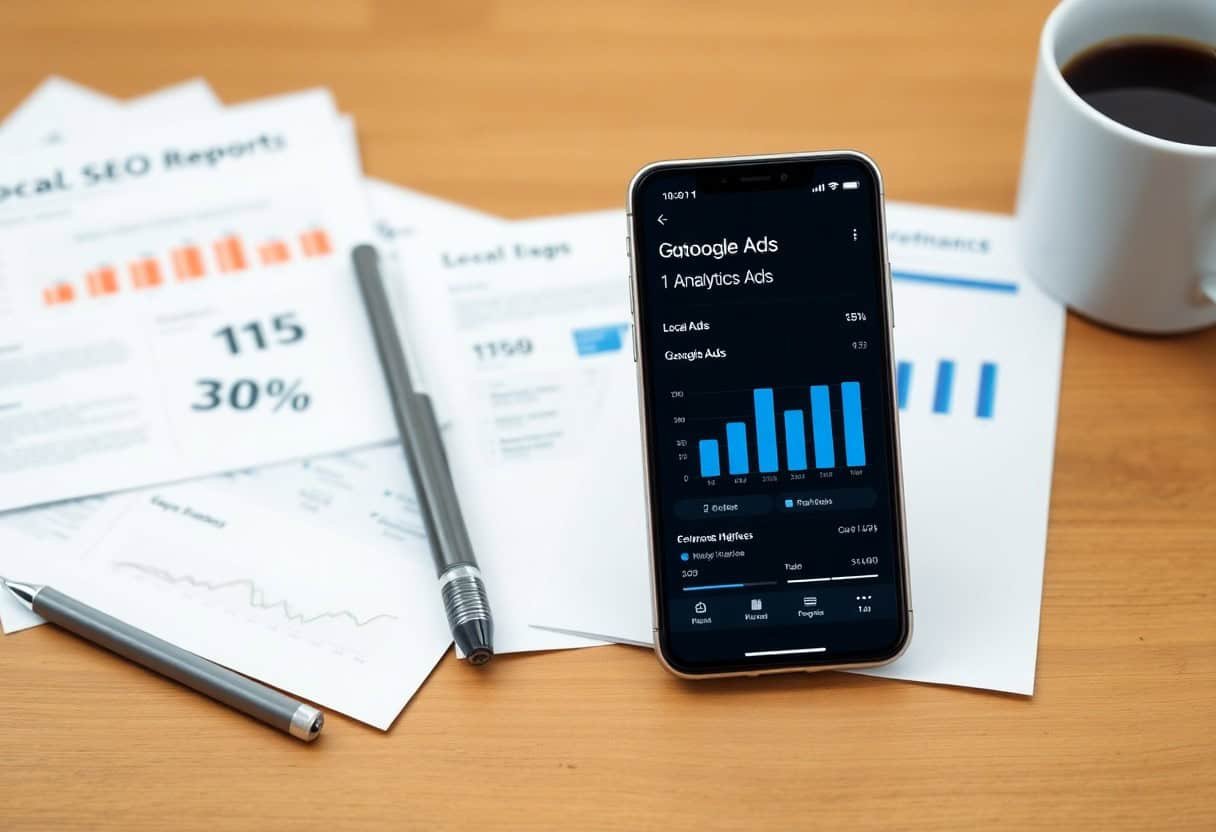Many business owners wonder if investing in Google Ads alongside local SEO is a smart strategy for boosting their online presence. You may be considering how these two approaches can work together to enhance your visibility in local search results. By understanding the benefits and challenges of both Google Ads and local SEO, you can make informed decisions that align with your marketing goals and drive more traffic to your business.
Key Takeaways:
- Google Ads can provide immediate visibility and traffic, complementing local SEO efforts, which typically yield results over time.
- Running both strategies together can help you cover more ground in search results, leading to higher overall online presence.
- Insights from Google Ads can inform local SEO strategies, such as keyword performance and audience targeting.
The Synergy of Paid Ads and Organic Strategies
Leveraging both Google Ads and local SEO creates a powerful synergy that enhances overall digital marketing effectiveness. Combining these approaches allows you to reach your target audience through multiple channels, increasing brand awareness and driving higher engagement. When managed effectively, paid ads can complement your organic search efforts, filling gaps in visibility and helping you dominate search engine results pages.
Interplay Between Google Ads and Local Search Rankings
Google Ads can positively influence your local search rankings by driving traffic and engagement to your website. Increased user interaction signals to Google that your business is relevant, which can improve your overall local SEO performance. Moreover, running ads for high-value keywords helps you gain immediate visibility while you build your organic search authority over time.
Enhancing Visibility: Dual-Channel Benefits
Utilizing both Google Ads and local SEO maximizes your visibility, ensuring you reach your audience regardless of their search behavior. While organic listings build credibility and long-term traffic, ads provide instant results and targeted outreach. For example, businesses that integrate both strategies often see conversion rate improvements of up to 30%, as users are more likely to trust a brand present in both paid and organic results.
Cost-Benefit Analysis: Are Google Ads Worth the Investment?
Evaluating your budget for Google Ads against potential returns is vital for determining their value. While these ads can drive immediate traffic and visibility, consider factors like click-through rates and conversion costs. If you allocate funds wisely and target the right audience, Google Ads can yield significant ROI. A/B testing different ad formats or campaigns can also help refine spending strategies, making it easier to pinpoint what works best for your business goals.
Evaluating Advertising Spend Versus Organic Efforts
Comparing the cost of Google Ads with investments in local SEO reveals distinct advantages and disadvantages. Google Ads provides instant visibility and leads but can accumulate costs quickly if not monitored properly. In contrast, local SEO requires a slower buildup but tends to have lower long-term costs once established. Balancing your expenditure between the two allows for a more comprehensive approach to attracting customers.
Long-term Value of SEO versus Immediate Results from Ads
SEO typically offers sustainable benefits that continue to attract traffic long after the initial effort. Once your site ranks well organically, ongoing costs decrease significantly compared to the continuous payments required for advertising. While Google Ads can generate quick traffic spikes for promotions or new products, that influx typically halts once the ad spend stops. Strategically investing in both can optimize short-term gains while building a solid foundation for long-term visibility.

Target Audience Insights: Reaching Local Customers Effectively
Understanding your target audience is vital for effectively reaching local customers. By analyzing demographics, interests, and online behaviors, you can create tailored marketing strategies that resonate with potential clients. Local insights can help refine advertising messages, ensuring they address specific needs and preferences. For instance, utilizing community events or local trends in your campaigns can foster a connection with your audience, ultimately driving traffic to your business whether through organic searches or paid ads.
Tailoring Ads for Local Demographics
Crafting ads that reflect local demographics enhances relevance and engagement. By utilizing data from platforms like Google Analytics, you can identify characteristics such as age, gender, and location of your ideal customers. This information allows you to create targeted ad copy and visuals that resonate with local interests. For example, a small bakery could showcase seasonal treats popular in your area, making your ads more appealing to nearby customers.
Utilizing SEO to Capture Organic Traffic
Implementing effective SEO strategies is key to capturing organic traffic from local search results. By optimizing your website and content for local keywords, you can increase visibility among users searching for your services. Creating location-specific landing pages, optimizing Google My Business listings, and engaging in local link-building efforts all contribute to enhanced local rankings. This organic presence not only complements paid ad efforts but also builds trust and credibility with potential clients.
Leveraging SEO techniques allows you to connect with customers actively seeking your products or services. For instance, if your business is a landscaping service in Denver, creating content around “best landscaping tips for Denver’s climate” can drive relevant traffic. Local citations and reviews also play a significant role; listing your business on local directories and gathering positive customer feedback will boost your visibility. This ongoing engagement cultivates organic traffic that feeds into your sales funnel alongside your Google Ads strategy, creating a comprehensive marketing approach.

Measuring Success: Key Performance Metrics to Track
Success in digital marketing requires continuous measurement. Track metrics such as conversion rates, click-through rates (CTR), and cost per acquisition (CPA) to gauge the effectiveness of both Google Ads and local SEO efforts. Utilizing tools like Google Analytics and Google Ads dashboard aids in assessing these performances. Establishing clear KPIs aligned with your business goals will ensure you can interpret results accurately, allowing for informed decisions and adjustments as needed.
Analyzing ROI from Google Ads
To understand the return on investment (ROI) from Google Ads, calculate your total revenue generated against your advertising costs. If you spend $500 on ads and generate $2,000 in revenue, your ROI is 300%. Regularly analyzing these figures helps determine if your ad strategies are effective and where to adjust your spending for optimal returns.
Tracking Local SEO Performance
Measuring the effectiveness of your local SEO efforts involves monitoring organic traffic, keyword rankings, and conversion rates from local search results. Use tools like Google Search Console to track performance metrics such as clicks, impressions, and average position for local keywords. Consistent evaluation will enable you to refine your strategy based on what’s driving traffic and conversions, ensuring that your SEO efforts remain aligned with your business objectives.
Focus on tracking metrics like local pack visibility, website traffic from local searches, and online reviews to gauge your local SEO impact effectively. Assessing user engagement through bounce rates and session duration can also reveal how well your content resonates with local audiences. Employ tools like Google My Business Insights to gain further insights into customer interactions and optimize your presence based on actual performance data.
Expert Opinions: Industry Perspectives on Paid and Organic Approaches
Industry experts emphasize that combining Google Ads with local SEO offers a well-rounded strategy for maximizing visibility. Many recommend using paid ads to kickstart your online presence, especially in competitive markets, while organic SEO builds long-term credibility and customer trust. This dual approach can significantly enhance both brand awareness and lead generation, catering to a diverse audience and meeting varying user intents.
Insights from Digital Marketing Specialists
Digital marketing specialists often highlight the value of diversifying your marketing strategy. By investing in both Google Ads and local SEO, you can capitalize on immediate traffic from paid ads while cultivating organic search presence. This approach not only improves your click-through rates but also creates a more robust online footprint, making it easier for potential customers to find you across multiple touchpoints.
Common Misconceptions Debunked
Many businesses believe running Google Ads undermines local SEO efforts, but these methods can coexist harmoniously. Some think that paid ads will overshadow organic listings, when in reality, they can drive more clicks to both channels. The idea that one must choose between the two is a misconception that often leads to missed opportunities for enhanced visibility in search results.
Debunking the misconception that Google Ads and local SEO are mutually exclusive reveals how both strategies enrich each other. For instance, paid ads can provide immediate visibility and data on user behavior, which can inform your organic strategies. Furthermore, appearing in both paid and organic results builds credibility and reinforces brand recognition with consumers, leading to higher engagement and likelihood of conversion. Utilizing both avenues ensures that you don’t rely solely on one source of traffic, fostering resilience in your marketing efforts.
Summing up
Considering all points, running Google Ads alongside your local SEO can enhance your visibility and attract more customers. While local SEO builds organic search ranking over time, Google Ads provides immediate results through targeted advertising. By integrating both strategies, you can reach a broader audience, drive more traffic to your business, and improve your overall online presence. Balancing these approaches allows you to capitalize on both short-term gains and long-term growth in your local market.
FAQ
Q: Should I run Google Ads if I am already using local SEO?
A: Yes, running Google Ads alongside local SEO can provide complementary benefits. While local SEO improves organic visibility over time, Google Ads allows for immediate visibility in search results. This combination can help capture a wider audience and enhance overall online presence.
Q: What are the advantages of combining Google Ads with local SEO?
A: Combining Google Ads with local SEO increases brand visibility and drives more traffic. Google Ads can target specific demographics and locations, allowing for precise audience reach. Additionally, running both strategies can help gather data on keywords and user behavior, informing future SEO efforts.
Q: How do I manage my budget when using both Google Ads and local SEO?
A: Managing your budget involves allocating resources according to your business goals and performance metrics. Start with a small budget for Google Ads to test campaign effectiveness. Simultaneously, invest in local SEO for long-term growth. Monitor results regularly to adjust spending based on ROI from both channels.

